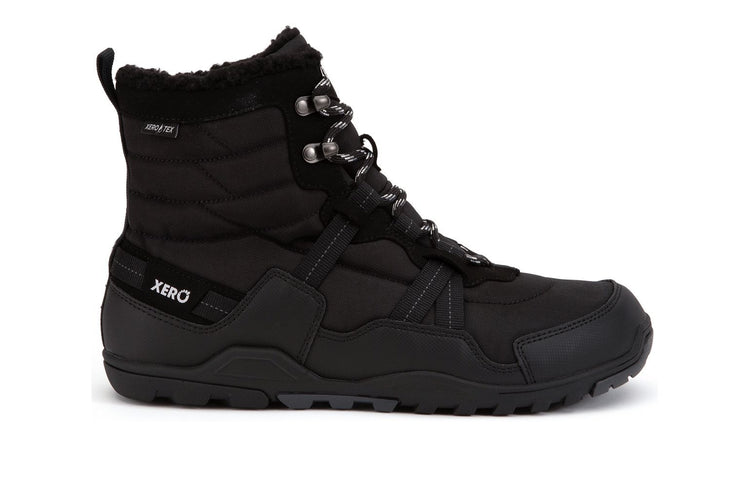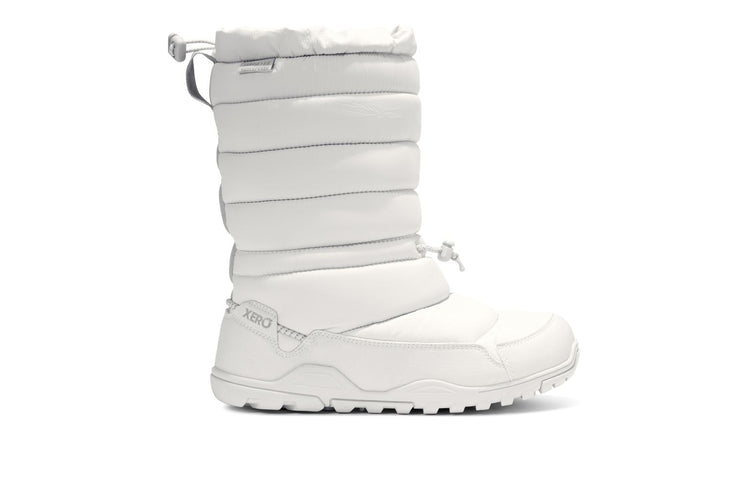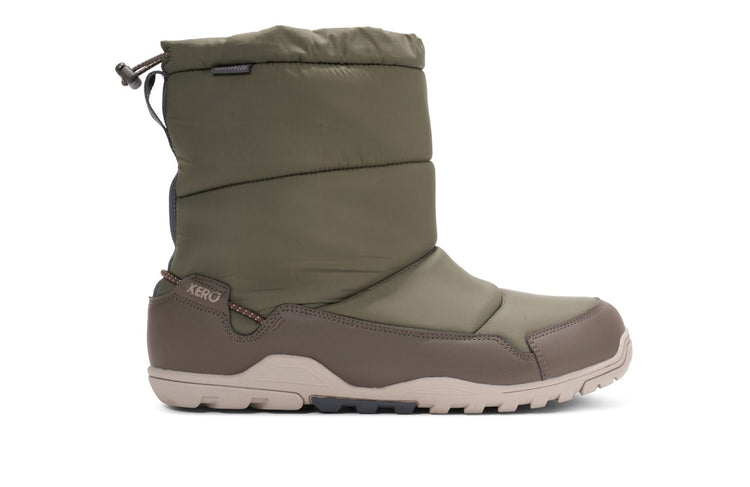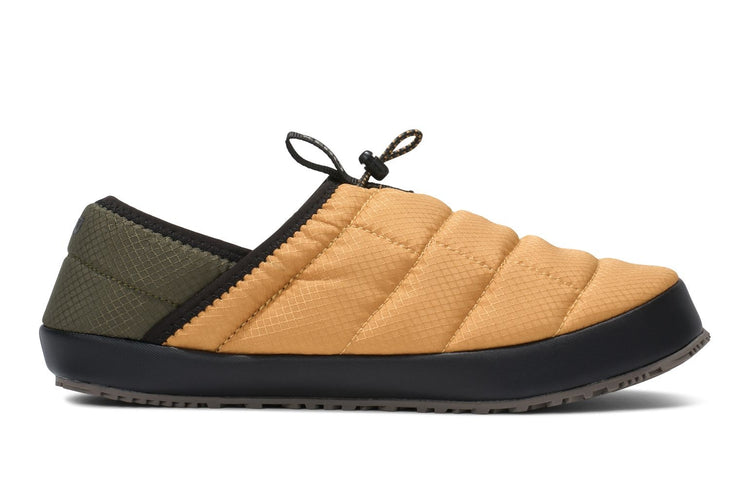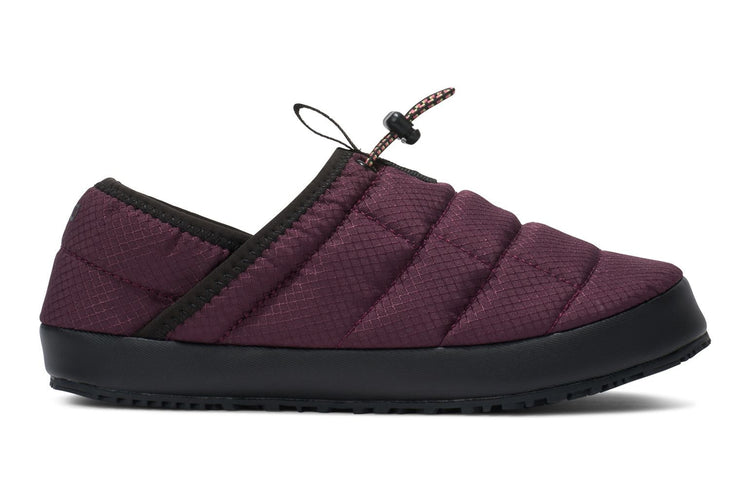latest News
Barefoot Running Sandals vs. Running Shoes
A barefoot running vs. running shoes "infographic" I'm get all geeky over well-presented information, and the graphic about barefoot running and regular running shoes from XRayTechnicianSchoools.net is a pleasure. Whenever someone says to me "Barefoot running can cause injuries" I remind them of the fact in 1/3 of the infographic: 90% (I heard 80%) of marathoners get injured each year. When people ask me about wearing barefoot running shoes in the winter, I remind them of that big squiggly time line showing that for hundreds of thousands of years, we would walk and run barefoot, without shoes, in some pretty cold places (in other words, your body, given time, will acclimate). And, I agree that being barefoot is not appropriate all the time... like when you want to get into a restaurant. Hence the value of our high-tech upgrade on the Tarahumara huarache-inspired shoes and sandals, where you still get a great barefoot feel, but can get into restaurants. I also got a great flashback from the 1974 timeline: I vividly remember getting my first pair of Nike Waffle Trainers. What's funny is that most people remember that it allowed you to land on your heel. I remember that it had such a large amount of "toe spring" (a curve up from the ball of your foot to your toes) that it kept me on my toes! (I was, and still am, a sprinter, so I don't spend much time running on my heels). AMAZING to see that barefoot running shoes are a $1.7 billion industry, in part because the market has grown MUCH faster than anyone imagined it would. But also because most of the barefoot running shoes are SO expensive. Minimalist shoes clearly doesn't mean minimalist prices, it seems ;-) And, of course, I agree about the best way to start barefoot running (there's no rush to make the transition out of running shoes and over to barefoot) Created by: X Ray Technician Schools The content of this post does not constitute and is not intended to be a substitute for professional medical advice, diagnosis or treatment. Always seek the advice of a physician or other qualified health provider with any questions or concerns you may have about your health or a medical condition.
How Barefoot is Barefoot, Really?
Okay, Pop Quiz time: Which of the following fictitious barefoot running shoes gives you more of a barefoot feel: a.) ASICs Nuttin’-2C with a 10mm thick sole b.) Brooks Zilch-City with a 1mm thick sole If you answered B, you’re mistaken. But if you answered A, you’re also wrong. Yes, my apologies, but this was a trick question. In the barefoot/minimalist footwear world, there are several concepts buzzing around, ideas upon which runners make buying decisions, that are potentially red herrings. In other words, these concepts can be used to inform or mislead, depending on how they’re used and how much other information comes along for the ride. And “sole thickness” is a biggie. If you look at ads for various minimalist and barefoot footwear products, sole thickness is highlighted. Sometimes bragged about. Thinner soles, some believe, are inherently better than thicker. Unless you’re a trail runner, then slightly thicker is better. Confused yet? You should be. Because, it’s not that simple. Let’s go back to my trick question.. The reason neither answer is correct is that I didn’t tell you what the soles are made of. If the 10mm sole was made of cotton candy, you may as well be running on the ground. But if the 1mm sole was made stainless steel, or carbon nanotubes, you wouldn’t be able to tell if you were on the ground at all. I’m exaggerating for effect — both comic and practical. But looking out in the market, you’ll see sole thickness used as a seeming shorthand for “barefootedness.” In other words, “thinner” means closer to barefoot. I recently had an Xero Shoes customer call me and tell me about his particular brand of minimalist shoe and how it advertised a 3mm sole. He wanted to know whether I thought his shoe was “more barefoot” than our 4mm Connect barefoot sandal. “Great,” I said, knowing the shoe in question. “It’s only 3mm thick. But is it flexible? Can you roll it into a tube?” “Well, no,” he said, clearly trying. “It’s pretty rigid.” “And if you put on that shoe and you stepped on a nail, how similar would that feel to stepping on it barefoot? Wait!” I added, hoping I wasn't too late to avoid a lawsuit, “Don't actually step on a nail to check!” I continued, “If you look inside that shoe, can you see the extra 2-3mm of insole padding they added to the 3mm outer sole?” “Uh-huh.” I could hear in his voice the first stages of someone starting to see through the fog of marketing hype. Many shoe marketers suggest, and many minimalist shoe buyers believe, that sole thickness is equivalent to “barefoot feel.” It’s not. It’s more complicated than that. When it comes to minimalist shoes, I feel compelled to paraphrase a line than no man wants to hear from a woman, “Honey, thickness isn’t everything.”
5 Common Stride Missteps
Let us guess, you ditched the cushioned clodhoppers only to find a new host of issues to deal with. Blisters on the bottom of your feet? Sore hips? Calves aching so much you can’t walk? Soak in some Epsom Salt and give yourself a break. No one said changing a lifetime of running habits overnight would be easy. No matter what shoe (or lack thereof) you wear, if you don’t change your stride, it won’t matter. Not sure if you’re “doing it right?” Below are five common missteps to set your stride straight.Misstep #1 Incorrect Stride RateWhen it comes to running, we get into a groove and find a familiar, comfortable place. We expect things to feel a certain way. Traditionally, runners trod along at roughly 120 steps per minute. With a forefoot or mid-foot stride, you need to speed up your stride rate and shorten your steps to roughly 180 steps per minute.Initially, it will feel very strange and awkward, and you may need to do some game time internal persuasion to stay consistent. Stick with it and you will be surprised how quickly you become accustomed to your new stride (and the pain-free knees that accompany). Remember, forefoot/mid-foot striding in minimalist shoes requires stronger calves, Achilles, tendons, ligaments and bones - you will slow down initially, but as you strengthen so does your speed. Take your time and slowly work your mileage up.Misstep # 2 Over-stridingOver-striding jars the body and puts unnecessary strain on your ankles, knees and back. Watch your feet closely as you run. Do your feet land under your center of mass where they should or in front of your body? The closer they are to you, the better. It is also common for runners to kick their legs out in front, then land lightly on the forefoot, rather than keeping a normal stride.Think of it as a modest can can dance in running form. Why add the extra stride and expend extra energy without the payoff? Keep your stride short and land under your center of mass.Misstep #3 Pushing/Pulling Your StrideAre you taking off for a run only to find a nasty blister swelling on the ball of your foot afterwards? When you push off for your stride, or pull your foot back towards your body to complete your stride, you’re smearing your foot across the ground. All of that extra friction is sure to create an uncomfortable blister or two. Keep your stride light and eliminate the foot smear and you will avoid blisters.Misstep #4 Incorrect Placing and Lifting of the FeetAre you jamming your foot to the ground and using a heavy stride? Going lighter and minimalist not only includes your shoe but your stride as well. When you run, imagine you are sneaking up on an elk in the woods or running on hot coals. Place your forefoot or mid-foot on the ground, then quickly lift it back up. The faster you move, the better. Doing this will keep your stride light, fast, and put less strain on your body.Misstep #5 AsymmetryHave you experienced a blister or soreness on one foot, but not the other? Pain in only one shoulder? Stronger strain in the right Achilles but not the left? Your symmetry is off. This is easy to do but also easy to fix. If you consciously try to have your feet, legs and arms move symmetrically in the same way, you will find most of your problems cease immediately. This becomes more crucial at the end of the run when you are fatigued and your stride isn’t as precise, your arms aren’t as stiff. Strive to keep yourself strong and symmetrical to the last step.Of course, there is the granddaddy of all missteps – the heel strike. We hope that no one is shedding their shoes only to pound their heels into the pavement (ouch!) Be sure to take on a forefoot or mid-foot stride and let your heel gently touch the ground as you roll through your step.Have you done any of these? We know we have! If you’ve overcome any stride challenges, do share. Your experiences may help someone else out there.Feel the World!The content of this post does not constitute and is not intended to be a substitute for professional medical advice, diagnosis or treatment. Always seek the advice of a physician or other qualified health provider with any questions or concerns you may have about your health or a medical condition.
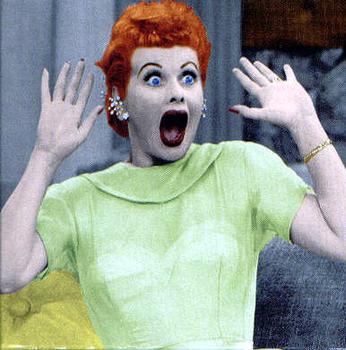
How NOT to start barefoot running
I was on a panel discussion about barefoot running a while back. At one point, someone in the audience asked, So how do I transition to barefoot running? NOTE -- even if you're not a runner, this story is still relevant and important for you... okay, back to the story... Before I could respond, a well-respected physical therapist suggested the following: “First, switch to a slightly lower-heeled shoe than what you have. Run in that for a few months. Then switch to a racing flat, maybe one day a week for a while… then add an extra day every month, until you can run in those. Then maybe try something like Vibrams on a soft surface, like grass in a park. Work up to being able to run on the grass… then try a soft dirt path. Eventually you may be able to run on hard surfaces, but don’t do that too often. And I don’t recommend being totally barefoot because you could step on something.” The only reason I didn’t interrupt him was that I was in shock! I had never heard anything so insane in my life. Until he he tossed out his next bit of barefoot running advice: “Expect to spend about 2 to 3 years making the transition. That’s how long I’ve been doing it and I’m still not there.” That's when my shock gave way to action, and I took off the politeness gloves. “Hold on,” I said, “this is completely upside down and wrong!” Danny Abshire from Newton jumped in as well, “Right, that’s backwards.” I’ll tell you what Danny and I proposed, instead, in just a moment. But first, let’s back up to the question that started it all. "How do you transition to barefoot running!?" The idea built into the question itself seems to make sense. If you’re wearing a motion-controlled shoe with a 3″ heel and a $400 orthotic, it seems logical that you need to slowly wean yourself from all that support. It seems clear that you would need to get comfortable in a lower and lower heel until you’re ready for barefoot. But as we've already seen in the previous days of this course, things are not always as they seem. Here’s the bottom line: There is nothing that “prepares” you for being barefoot. Nothing. Not “zero-drop” shoes (where your heel is at the same height as the ball of your foot). Not Vibrams. Not a thinner insole. Not even Xero Shoes (more about those in a second). Anything that you put on your feet will change either your stride and biomechanics, or the amount of sensation you’re feeling in your feet (or both) compared to being barefoot. So once you take off your shoes, or fully feel the ground, you’ll need to learn to move differently. Here’s where some people stop reading what I’m saying and respond with two arguments (to points I’m not making). First, they’ll say, “Oh, so you’re some sort of barefoot purist! Who are you to tell me what to wear or not wear?” To be clear, I’m not telling anyone what to wear and I’m not saying barefoot is the only way to be. Admittedly, the majority of my time I am in Xero Shoes, but not always (more about when I'm not, and when you shouldn't be in an upcoming lesson). This article is about the myth of “transitioning” to barefoot running, not about your footwear, or lack thereof. Secondly, people will say, “Yes, but switching to a racing flat or zero-drop shoe will give your Achilles time to stretch and strengthen, and that better prepares you for being barefoot.” To them I say, “Not always. And for almost everyone, your Achilles has more than enough stretch. And, even if it were true that you needed to stretch your Achilles, there’s a better way than spending 2-3 years to make that happen.” Keep in mind that the biggest reason for going totally barefoot is that feeling the ground with your skin gives you the most feedback about your form. Feedback that, if you attend to it, can inspire you to change your gait to something more efficient, easy, and natural. Running in Xero Shoes is, really, the same... if they covered everywhere you stepped in 4-6mm of flexible rubber. All the other shoes I've tested reduce the amount of ground sensation you feel so that you don't get the feedback you need to adjust your gait. I’ve seen hundreds of people in VFFs or racing flats who still heel strike or have some other gait pattern where they aren’t getting much if any extra “Achilles strengthening and stretching”. So, what’s the better way to “transition” that Danny and I chimed in with? Take off your shoes (or put on your Xero Shoes), find the hardest and smoothest surface you can find (like a bike path or street) and run. But only do it for about 200 yards. See how you feel the next day. You may be sore, you may be fine. If you’re sore, wait until you’re not. Then go try again, and add 100 or 200 yards. Repeat. I think of this as the “Shampoo method” of barefoot running. Instead of “Lather, Rinse, Repeat,” it’s run a little, rest, repeat (and run a little more). Keep in mind, there are two types of soreness. One is from using muscles you haven’t used in a while, or using them in a way you haven’t used in a while (if ever), or using them a bit more than usual. The other is from doing something wrong. Like doing way too much distance (which part of 200 yards was confusing to you?), or trying to stay on your toes without letting your heels ever touch the ground (Not necessary… land mid- or forefoot, but your heel can touch down. No need to do 200 yards of calf raises). In other words, a little soreness is probably normal. A lot of soreness is telling you to try something different. And this idea that you need to be on soft surfaces. Completely wrong. And wrong for the same reason that you don’t want to be in cushy running shoes. Give yourself a soft surface and the odds are good you’ll heel-strike. Plus, soft surfaces don’t give you the feedback you want, the kind that can help you quickly learn a new and better way to run. I’ve seen barefoot runners who’ve only run on grass, and they usually look like shod runners who lost their shoes. Instead of thinking that you can work your way to barefoot or huaraches slowly, go there immediately. But work your way up in time/distance slowly. All the strengthening that you want to do before you run barefoot, you’ll get that faster by running barefoot. All the stretching you need (if, in fact, you need any), you'll get that by building up your distance, slowly. To misquote Yoda’s famous “There is no try. Only do.” There is no transition, only run (or walk, as the case may be). Oh, and in the next lesson, I'll share some of the most important tips about exactly HOW to run barefoot, including some suggestions that, frankly, I never wanted to share with anyone... shhhhh. Let me know what you think. Put in your comments, below. The content of this post does not constitute and is not intended to be a substitute for professional medical advice, diagnosis or treatment. Always seek the advice of a physician or other qualified health provider with any questions or concerns you may have about your health or a medical condition.
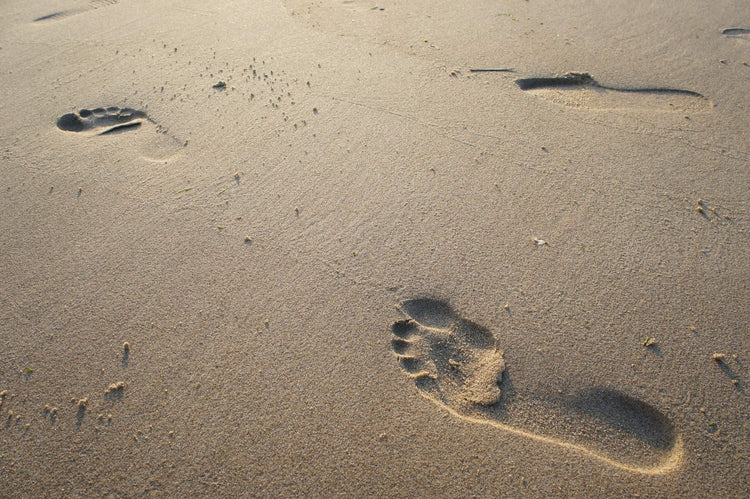
How to Avoid Barefoot Running Blister - Xero Shoes
This post was recently updated September 28, 2023. Getting a blister from barefoot running was the best thing that could have ever happened to me. It not only taught me about blister prevention but, literally, changed my life (and my wife’s too).. Let me back up and tell you the whole story so you can understand why. On my first barefoot run ever, I was so fascinated by the sensations, and so transfixed by experimenting with my gait to see the effects of different stride patterns, I didn’t even notice I had run 5k. Now that may not sound like much to you ultramarathon guys, but I’m a sprinter. I’d never run more than a mile before! About 20 minutes after the run, though, I noticed that I had a big blister on the ball of my left foot, behind my 2nd toe. It wasn’t lost on me that I only had a blister on one foot. And it was particularly interesting that it was my left foot, because most of the injuries I’d been getting (the ones that inspired me to try barefoot running, with the hope it would cure me), were in my left leg. Clearly, I was doing something with my left leg that caused the blister. Something I wasn’t doing with my right leg, which felt fine. A week later, I went out for a second barefoot run, well before the blister had fully healed. In fact, the blister had popped and I had a gaping hole on the bottom of my foot. I thought that I’d experiment some more and see if I could run in a way that didn’t hurt, figuring that if I wasn’t in pain I wouldn’t be doing what caused the blister in the first place. I figured I’d give myself 10 minutes and if I couldn’t find a way to run pain-free, I’d just stop and try again when the blister was healed. As I ran, I kept thinking, “How can I stop doing with my left leg what I’m already not doing with my right?” Instead of paying attention to the “bad” side, I put my attention on my “good” leg, my right leg, and wondered, “How can I just do THIS, whatever that is, with my left leg? But no luck. For the first nine minutes of that run I was in pain. I couldn’t find a way to run that didn’t hurt. About 30 seconds later, something changed. At the time, I didn’t know what it was, all I knew was that I was able to run without my left foot hurting. I wasn’t doing whatever it was that caused the blister in the first place. And, simultaneously, my running was easier, faster, lighter and used less effort than ever. I finished the run (only about 3k this time, but still…) and felt fine. That was over 14 years ago and the last time I’ve had a running injury. What changed? Before I answer that question, let me explain why blisters form in the first place. Understanding that will help the rest of what I say make more sense. And it will also help you see how you could prevent foot blisters in your own running. What Causes Blisters from Running, Anyway? It’s simple. Running blisters are caused by excessive friction. They occur when your skin is being rubbed in a way that damages it. Your body’s response is to gather clear fluid underneath the skin that is being damaged to protect the underlying tissues. As you know, they are painful — especially if the blister pops, exposing the raw skin underneath. When you are running in shoes, blisters can form any time your foot is sliding against your shoe. Obviously, a blister doesn’t form immediately. But when friction occurs from repeated rubbing of any part of your feet or toes inside your shoes, eventually you’re going to wind up with a painful blister. As my story highlights, this can happen when running barefoot, too. The way your foot makes contact with the ground can also generate the excessive horizontal force, the friction, that leads to blisters. Barefoot running blisters certainly aren’t necessary; nor are blisters when wearing running shoes. The key is to prevent the friction that causes them to form in the first place. So how do we do that? The Running Mistakes That Lead to Blisters When runners get blisters, it is often because they are doing one or more of these three things: Overstriding (landing with their foot too far in front of their body – effectively putting on the brakes – rather than placing it under — or closer to — their center of mass) Pulling their feet towards them (which, by the way, also puts strain on the hamstring) Pushing off with their toes (sometimes called “toeing off,” instead of initiating lifting your foot off the ground by flexing the hip, the motion you do when raising your knee)) If you think about the mechanics of how blisters form, you can see the problem here with all three. Each of them creates excessive horizontal force, excessive friction. When it came to my own blister, I discovered I was doing the first of these, with one extra mistake. More about that in a moment. Let’s dive into each running form mistake to help you avoid blisters in the future. Mistake #1: Reaching out with your feet: When you land with your foot too far in front of your body, you’re applying braking force on your feet every time they hit the ground. In other words, as your foot hits the ground, the momentum of your body wants to continue forward but your foot is pushing back against it. Exactly what happens next depends upon what you’re wearing. If you have nothing on your feet, your skin is likely to grip the ground, preventing it from sliding. This means stress on your tissues as lower layers essentially tug against the upper layer of your skin. If, on the other hand, you overstride while wearing a running shoe, your foot is probably going to slide within the shoe as the shoe’s sole grips the ground securely. Whichever happens, this repetitive rubbing can generate blisters. The location will vary, however, depending upon your foot strike pattern. If you land heel first, you’re likely going to get blisters on your heels. (By the way, landing on your heels is a bad idea for other reasons, too. It creates significant impact forces that are hard on your joints and tissues.) If you land mid-foot or toward the front of your foot, you’re going to see blisters on the balls of your feet. This is what I was doing since, as a sprinter, I wanted to land on the ball of my foot. I was overstriding and pointing my foot. How to prevent this issue: The solution to this blister-causing stride pattern is landing your steps closer to under your body as you run. Mistake #2: Pulling your feet Many runners can fall into this habit because it feels like a way to gain more speed – to essentially pull your body forward with your foot against the ground. The result is just like what happens when you land with your feet too far out in front of you, only this time the direction of the rubbing is the opposite. You still end up with increased friction on the bottom of your foot and the resulting blisters. How to prevent this issue: If you stop overstriding, and land with your foot under your body, you’re less likely to pull your foot when it’s on the ground, reducing the chances of developing this type of blister. Mistake #3: Pushing off This is similar to pulling with the foot, though here it isn’t pulling with a foot out in front of me but trying to give an extra push forward with a foot beneath or behind me, by flexing your toes, or what some call “toe-ing off.” You can probably see how this puts horizontal pressure on the toes, creating more friction. The correct motion simply involves lifting (not pushing) your foot off the ground by flexing your hip. In other words, imagine that you step on a bee… you wouldn’t push off the ground since that would drive the stinger further into your foot. Instead, you would reflexively flex your hip, which lifts your foot off the ground. How to prevent this issue: To prevent a pushing-off blister while running, you want to think about lifting the foot rather than pushing off. I could summarize all three of these things by saying you should try to run in such a way that minimizes horizontal forces applied to the bottoms of your feet. Your feet should come and go down with as little braking, pushing, pulling, or sliding as possible If you want to prevent blisters, in shoes or not, it can help if you learn how to run barefoot in a way that minimizes friction. Other Tips to Prevent Blisters Your shoes and your form are probably the most important things to pay attention to if you want to prevent blisters. There are two other things that can be helpful to keep in mind, however: Moisture: Moisture is your enemy when it comes to blisters. As surprising as it might sound, moisture increases friction and can also make your skin more susceptible to damage. If you need to, you can use talcum powder (like baby powder) to help absorb moisture. Running Socks: Socks are a useful way to control moisture when you run wearing shoes. We could get into a big discussion about which are the right socks (Cotton socks? Wool? Double-layer socks?), but I’ll save that for another time. Running socks are usually specially designed to wick away moisture. If you do choose to wear socks to help keep your feet dry and reduce friction, look for the thinnest socks you can find to preserve as much as possible the natural feedback we’ve talked about above. Moderation: While it’s possible to run long distances, in shoes or bare feet, without getting blisters, sometimes our form breaks down when we’re tired. Or the terrain makes it hard to have good form for your whole run. Even in the best of circumstances, your skin can only take so much, especially when you are getting started or beginning to push to longer distances. Runners sometimes resort to extra tricks like applying duct tape or an anti-chafing balm when they know they’ll be dealing with tiredness and their form breaking down at the end of a longer-than-usual run. I get it; sometimes you feel like you need to be out there, even despite your blisters. In general, though, I think it’s best to take it slowly and, again, listen to your body. To summarize, run in a way that minimizes friction on your feet, stay away from ill-fitting shoes that don’t let your feet move naturally, keep your feet dry, and be prepared to listen when your body is telling you to stop or slow down. If you do get them, treat blisters and take some time off so your body can heal. Can Barefoot Running Help Prevent Blisters? I began by telling my own story about getting a blister when I started experimenting with barefoot running. While I’m not suggesting you run barefoot, it was certainly life-changing for me. One of the best things about barefoot running is that bad form hurts, and good form feels great. So you learn right away to listen to the feedback your body is giving you and to make adjustments. All of the padding and support in traditional running shoes actually prevent you from really feeling what’s going on. With barefoot running, you become attuned to the effects of your form and can use that input to coach yourself to become a better runner. It’s an ongoing process of continual improvement. I believe a better form is going to be better for your body in every way, including reducing the chances of getting blisters. But What About Barefoot Shoes? Given what I’ve said about running barefoot, you might be wondering what I’d say about barefoot shoes. Do they give any advantages when it comes to blister prevention? One of the reasons for blisters is the foot rubbing that comes from the way you’re running, as we discussed above. Another reason many runners get blisters, however, is because of the shoes they are wearing. If your shoes don’t fit properly or move properly with your foot, you are going to have issues. Think about it. The bones, joints, and muscles in your feet are designed to move as you walk or run. They are not solid, immovable objects. That means your shoes need to be able to move with your feet to reduce or eliminate friction. Traditional running shoes fall short in this area. They are too stiff to flex naturally and usually too cramped in the toe box to allow your toes to move freely. Instead, they end up rubbing against the sides of the shoe, or against each other, both of which can be blister-causing. A still heel can also lead to blisters on the Achilles. After my barefoot blister experience, I wanted to keep getting that feedback, and enjoying that natural motion. Plus having no extra weight on my feet felt great, too. But I also wanted to get into restaurants without arguing about whether it’s legal to be there without shoes (it is, by the way… but they can have a policy about footwear). Plus, my wife got tired of me bringing my dirty, bare feet into our white carpeted house. Put all that together, and that led to my wife and I starting Xero Shoes, making footwear that gives that barefoot feeling, plus some protection. (Now you know how my blister changed my wife’s life, too ;-) ) How Barefoot Running Shoes Can Help Prevent Blisters Barefoot running shoes are designed with a thin, flexible sole and a roomy, foot-shaped toe box. This kind of shoe is going to do three things for you. First, it is going to allow you to maintain that ground feel I was talking about earlier. You’ll be able to listen to the feedback your body gives you to hone in on your ideal form. Second, barefoot shoes will move with your feet, helping to prevent blisters. And third, the wider toe box can keep your toes from rubbing against each other. People sometimes think it is inevitable that new running shoes will hurt your feet. This just isn’t true. New shoes that actually move with your feet and have enough room for your toes can feel great from day one. Closing Out: Barefoot Running and Blister Prevention It’s no fun to get foot blisters. But my first barefoot running blister was the best thing that ever happened to me as a runner. It taught me to listen to my body and I’ve become a much better runner for it. In fact, not only did my injuries go away, but I became a Masters All-American sprinter. For men in my age group, I’m one of the fastest in the country. I can’t promise you’ll become a nationally ranked runner, but I hope this info helps you have more fun doing whatever you do on your feet and Live Life Feet First! The content of this post does not constitute and is not intended to be a substitute for professional medical advice, diagnosis or treatment. Always seek the advice of a physician or other qualified health provider with any questions or concerns you may have about your health or a medical condition.
Are we really Born To Run? Ask Christopher McDougall...
Are we really born to run? If so, what allows us to run as far as we do for as long (into old age) as we do?Here's what Chris McDougall, author of Born to Run, says at his TEDx talk:
Getting started with barefoot running
Imagine that you haven't lifted weights in a while... or ever.And imagine that you got the idea that you wanted to bench press 500 pounds.Would you go to the gym, put 500 pounds on the bar, and just go for it?Of course not. There's no way you could budge 500 on day one.Would you go to the gym and put, say, 100 pounds on the bar and lift it, over and over, until you felt tired... and then do a few more reps until you were wasted?I hope not.Would you take a small weight, like 20 pounds, and lift it for an hour or two?Boy, I wouldn't.But for some reason people think they can get into barefoot running with one of those plans.They think they can just whip off their shoes and replace one of their regular runs with a barefoot run. Or, worse, they think that even if they haven't run for a decade, it'll be fine to go for a 5 mile barefoot run. Or they get out for a barefoot run, feel some strain or pain in their feet or calves and think, "Oh, I'll just work through this, it'll be fine."And they pay the price.They wake up with freakishly sore calves or Achilles tendons. They get blisters. They get plantar faciitis. They get stress fractures.Look, over-training is over-training. Doing too much is doing too much.Especially with barefoot running, TAKE YOUR TIME. There's no rush to get to the point where you're running an ultramarathon every day for 1000 days in your bare feet. And there's no way to rush building up the strength in your muscles and ligaments and tendons, or to develop correct and efficient form.It happens as it happens. No sooner, no later.How long that'll be is a mystery. Maybe it only takes you a week or a month. Maybe it takes you a year.Who cares?First of all, it's not all-or-nothing. It's not like you won't be able to be barefoot and then, BAM, 6 months from now you can! It's a process. Maybe today you can only run 100 yards and then need to ice your feet for 3 days. That's fine. In a month, guaranteed, you'll be doing more. And a month after that, you'll be doing even more.Secondly, nobody is telling you to throw away your shoes the moment you realize you want to become a barefoot runner. Keep your shoes. Enjoy your shoes. And look forward to when you don't want or need them.But, please, give yourself time -- the amount of time that YOU need -- to make the transition.Honestly, there's enough to learn and experience and benefit from if all you ever do is an occasional 1 minute jog without shoes.I hate to toss out "prescriptions for living," but in this case I can't think of any better way to say it than, "Enjoy the journey... because there isn't really a goal."The content of this post does not constitute and is not intended to be a substitute for professional medical advice, diagnosis or treatment. Always seek the advice of a physician or other qualified health provider with any questions or concerns you may have about your health or a medical condition." to the bottom of the blog post.The content of this post does not constitute and is not intended to be a substitute for professional medical advice, diagnosis or treatment. Always seek the advice of a physician or other qualified health provider with any questions or concerns you may have about your health or a medical condition.
Running Barefoot -- The Importance of Core
Usain Bolt's coach, Glen Mills, talked in an interview about what helped make Usain Bolt the fastest man in the world. He revealed something that will surprise most runners, namely, the most important muscles required for fast, efficient running. Have a guess? Think it's the quads? The hamstrings? Glutes? Calves? Eyelids? Let me quote Glen: Usain is an extremely gifted athlete. When I started working with him, one of the things that stood out like a sore thumb was his poor mechanics. Part of his poor mechanics was because he was not able hold the sprint position during maximum velocity running, so we had to do an intense programme to develop his core strength. In Beijing he showed a mastery of the technique that we had been working on, but the transformation took two years. He goes on to discuss in more detail how important the core -- primarily the abdominal muscles -- are critical for running. Now, what does this have to do with your running? EVERYTHING. Next time you run, tighten your core (as if you're bracing yourself before someone hits you in the stomach). See what that does to your running form. Play with this. See what changes as you tighten your core, especially the transverse abdominis (the muscles you use to suck in your stomach when you're trying to fit into a pair of too-tight pants). Well, if that's not the motion you make when running, is it the best thing to use for training? Strength coach Michael Boyle discusses this and suggests that if you want to keep your core stable, you should train it to remain stable while some force is trying to move it. Looking forward to hearing what you discover when you activate "the most important muscles for running." The content of this post does not constitute and is not intended to be a substitute for professional medical advice, diagnosis or treatment. Always seek the advice of a physician or other qualified health provider with any questions or concerns you may have about your health or a medical condition.


